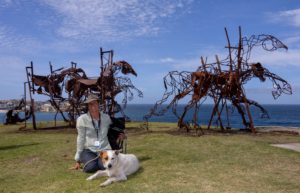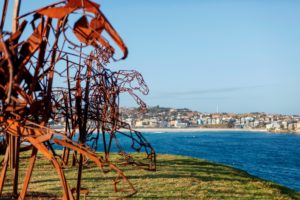Posts tagged Sculpture by the Sea

Harrie Fasher, Beersheba and Sculpture by the Sea 2017
Dec 28th

Harrie Fasher with her biggest sculpture to date, The Last Charge, at Sculpture by the Sea in Bondi, Australia, 2017. Image courtesy of Sculpture by the Sea.
This year I had a great interview with rural NSW artist Harrie Fasher about her work for Sculpture by the Sea, titled The Last Charge.
The story was for the Daily Telegraph, and you can see it here.
For the record, however, here’s the interview in full.
Elizabeth Fortescue: Harrie, what materials did you use for The Last Charge?
Harrie Fasher: Corten steel and mild steel.
EF: Did you use oxyacetylene to put it together?
HF: This has been a real battle. It also has industrial I-beams and RHS which is rectangular square section. It’s MIG-welded together and plasma cut. Then ground back using angle grinders.
EF: It sounds very physical.
HF: We’re up and down off the scaffold and the other day I was having a joke about going to step classes at the gym. It is a hugely physical process. There’s no way I could do it alone. I’ve got a team with me in the studio. I’ve got a studio assistant, Megan. She’s been working with me for three and a half years. My farmer next door has been (helping). It’s been very much a team effort. Every artist needs a farmer, is our joke. I live in the middle of a working farm. He’ll help me twist the I-beams or we were heating pieces of steel in a bonfire at one point and he was whacking it with a sledgehammer whilst I was moving it on the chopping block. He has no previous art experience. He’s not overly engaged with the art. But everybody wants to be a part of it. It’s this amazing thing that so many people want to be a part of making art. It blows me away.
EF: Has he helped you with other works for SxS?
HF: Yeah, he’s always helping me. He brings down the tractor so we can move stuff around and load trucks. Metal Land in Bathurst sponsors me and gives me a fair chunk of the steel that goes towards SxS and they lend me their truck. This time it’s going to take two trucks to get it to Bondi. This will be the fourth Bondi that they’ve been involved in. They love it. I don’t know if it’s just a rural thing that there’s all these people that want to be involved in it, but there’s a woman I went to art school with and she lives at O’Connell and she comes whenever she can and cuts pieces. It blows me away how many people want to be a part of things like this. I have a huge network. I think sculptors need friends. I can’t move the sculptures by myself.
EF: What’s the farmer’s name?
HF: Geoff Salmon. And Steve Hogan was my first farmer. (Now he’s making his own sculptures.) He does one or two days a week (for me).
EF: Tell me about your assistant.
HF: My assistant is Nicole O’Regan. She’s a steel fabricator by trade. She’s two years younger than me. Been working with steel since she was 16. Working with another woman is just fabulous. Working with men is quite different. You constantly have to assert yourself a little bit. She’s a crucial part of my team.
EF: How far from Geoff, the farmer, do you live?
HF: I live in the middle of his property of 1200 acres at Oberon. I live in the middle on 12 acres on a property called Essington Park owned by the Logue twins, Joanna Logue and Simone Logue. King Street (King Street Gallery on William) have just taken me on board. I’m going to have my first solo show with them in June. Joanna has the other half of the studio I’m in. The girls’ block, Essington Park, is in the middle of Geoff’s place called Ambleside. Geoff’s son Tim now manages the family property. Sheep and cattle.

The Last Charge, by Harrie Fasher. Sculpture by the Sea, 2017. Image courtesy of Sculpture by the Sea.
EF: Tell me about The Last Charge.
HF: Eight horses, slightly larger than life. I don’t think I knew what I was taking on. Seven of them are in full gallop. I started the project with a maquette, but I started without a notion of how it was going to look. I wanted to create an emotional response which is to feel what it would have been like to face a full cavalry charge, being over-run, what it would have felt like to be in the Turkish trenches and have these 800 horses galloping at you. And at first I thought I’d make 800 and fill Tamarama Beach and then I thought that would be a bit ludicrous but in reality eight is quite a lot.
One of the horses is fallen. That horse has a real beauty about it. Something quite poetic about the fallen horse. Sometimes I relate to them and I feel them as the men. My mum’s always told me not to anthropomorphise my dogs, but I think I do that with the sculptures. The sculptures are the men, and they embody all these different characteristics that go into making up the myth that’s become part of the Australian culture. They have the courage and the fear and the determination, but they also have a strange ghostliness. Some days I relate to them as this powerful, charging, conquering mass of horses and some days I relate to them as being ghostly.
It was a very successful charge, and one of the only ones because the Light Horsemen actually fought on foot. One person would hold five horses and the rest would fight on foot. Rarely held an old fashioned cavalry charge. It meant the Turkish weren’t able to realign their gun sights. They weren’t prepared for them. The horses were desperate (thirsty). If they didn’t take the town they had a 12-hour ride to water, and there’s that real thing about survival where the men depended on the horses as much as the horses depended on the men. There’s great stories about horses falling in battle and the men then retaliating in revenge for the horse.
EF: All the horses had to be shot at the end of the war, because they couldn’t be brought back home to Australia.
HF: I’ve read how calm it was when they put them down but because the horses trusted the men so much and they were used to gunfire, there wasn’t any panic. They cut their manes and tails and took their shoes off, and hides, because all of that was worth money to the army. Can you imagine skinning your own horse? It would have been heart-breaking. All the time you’d be thinking, ‘oh when I get back with my horse’. People do ask me why I have to have a dead one, a dying one, and I say ‘well it’s a reality check. War isn’t pretty’.
EF: You have two horses on the farm, Dusty and Evie. Did you use them as models for your sculpture?
(Harrie said she saves pictures from the form guide, and also uses horse books.)
EF: Tell me about your forebear who was in the Battle of Beersheba.
HF: Major Lachlan Alfred Macpherson, (known as Alf). He was mum’s great uncle so he was my great great uncle. Born in 1884. We have portraits of him in uniform. I have his medals which I wear on Anzac Day. He won an MC and a DSO. He was at the Battle of Beersheba. The eighth Australian Light Horse. He fought everywhere. He survived the war and came home and settled near Goulburn. I think he was near Gundagai before he went to war. On a property where he grew up. We’ve only just started investigating this connection. It is rather amazing. I went to France on a field trip with a whole lot of landscape painters from King St and Stella Downer and Watters. In May. We were going to do an exhibition on the Western Front. France and Belgium. It gave you a real insight into what they faced and how impossible it was, the missions they were on.
EF: Do you sometimes help Geoff on the farm, the same as he helps you with your sculptures?
HF: Geoff asked me to come and help him pull a cow out of a bog.
EF: Did you get it out?
HF: Yep. She’s out.
Posted by Elizabeth Fortescue on December 28, 2017
